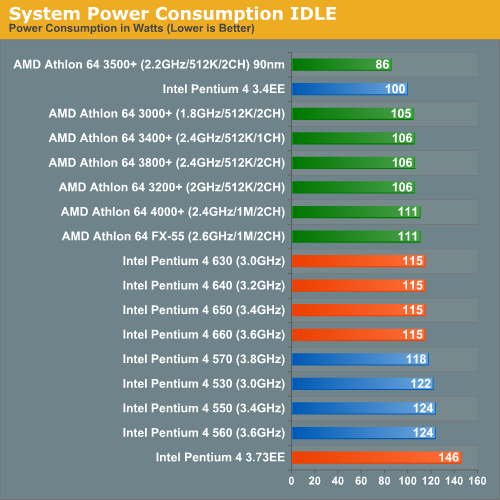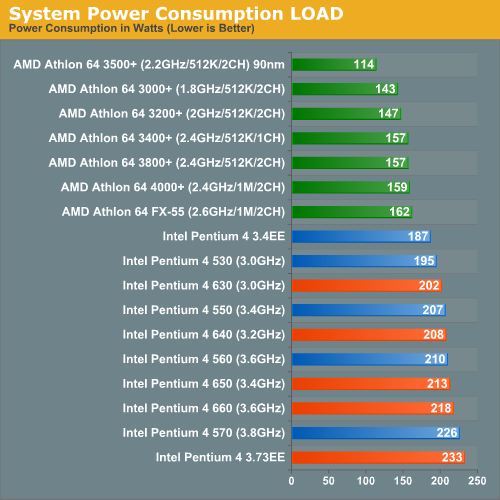Intel Pentium 4 6xx and 3.73EE: Favoring Features Over Performance
by Anand Lal Shimpi & Derek Wilson on February 21, 2005 6:15 AM EST- Posted in
- CPUs
Lower Power Consumption
Over time, any good chip manufacturer will be able to tweak and fine tune their manufacturing process to improve yields. The first 90nm Pentium 4s have been in production for over a year now, and thus it's not too far of a stretch to think that today's 90nm Pentium 4 6xx CPUs are being built on a higher yield 90nm process. In addition to normal tweaks in any manufacturing process, the new 6xx series introduces a handful of power saving techniques that help to reduce overall power consumption of the chip.
First introduced in the 5xxJ series, the Enhanced Halt State (C1E) and Thermal Monitor 2 are both mechanisms included in the 6xx series to reduce power.
Whenever the OS executes the halt instruction, the CPU enters what is known as the halt state. Architecturally what's going on in a halt state is the clock signal is shut off to the CPU for some period of time, with no clock signal none of the logic in the chip will do anything and thus power consumption is reduced. Performance is also significantly reduced, however the halt instruction isn't usually called during application usage, so the performance aspects of the halt state aren't very important.
The problem with the halt state is that it does nothing to reduce voltage, only current draw by stopping clocks from going to the CPU. Since Power varies linearly with both current and voltage (P = I * V), you're effectively only addressing half of the problem. The Enhanced Halt State, as Intel calls it, does two things - it reduces the clock speed of the CPU by decreasing the clock multiplier down to its minimum value (on the 6xx series that's 14x, or 2.8GHz) then reducing the voltage. The clock speed is reduced and then the voltage is dropped, to maintain stability.
Intel insists that the enhanced halt state is a significantly lower power state than the conventional halt state, thanks to the reduction in voltage in addition to the reduction in clock speed. While the standard halt state causes a linear reduction in power, Intel's enhanced halt state causes an exponential decrease in power, potentially offering better power savings than the standard halt state. The real world impact obviously depends on how idle your system happens to be.
When the Pentium 4 was first launched there was a lot of bad journalism out there about how it would overheat and reduce its clock speed significantly thanks its integrated Thermal Monitor. If the Pentium 4 sensed that it was operating outside of safe temperatures, its Thermal Monitor can reduce the effective clock speed of the CPU by approximately 50% - once again by cutting clocks to the CPU. In reality, the Pentium 4's clock throttling never actually came into play unless your fan stopped, or your heatsink fell off. More recent Pentium 4s however have been pushing the thermal envelope further and further, finally to the point where throttling can be a problem if you don't use high quality thermal compound and make sure your heatsink is absolutely secure. The performance reduction when the processor throttles is usually pretty significant.
With the new 6xx series of CPUs, Intel introduces Thermal Monitor 2 (TM2) which, as in the case of the enhanced halt state, reduces clock speed (to 2.8GHz) and voltage as well. The performance impact due to TM2 is much less than the original implementation, so it can actually be triggered during normal use without an overly noticeable loss of performance. However if reducing the clock speed and voltage isn't enough, the CPU will still shut itself down in order to avoid any damage just like the other Pentium 4s did.

Yes, we ran Windows Media Encoder 9 with the fan off for 5 minutes.
But both the Enhanced Halt State and TM2 were introduced in the 5xxJ CPUs, what's new to the 6xx series is the Enhanced Intel SpeedStep Technology (EIST). What EIST does is very similar to AMD's Cool'n'Quiet, it is demand based reduction in CPU clock speed and voltage. Using the same mechanism of adjusting clock speed and voltage, based on the application demand, the Pentium 4 6xx will dynamically increase/decrease its clock speed between 2.8GHz and its normal operating frequency, as well as voltage, in order to optimize for power consumption.
Because of the way EIST (and AMD's Cool'n'Quiet) works, there's inherently a drop in performance. The idea is this - if you're performing a task that's not using 100% of the CPU, the CPU will operate at a slightly reduced frequency in order to conserve power. So while some tasks will require that the system run at full speed, others will run at speeds as low as 2.8GHz. With a minimum multiplier of 14x, slower Pentium 4 6xx CPUs won't get a huge benefit from EIST. For example, the Pentium 4 630 runs at 3.0GHz, meaning the drop down to 2.8GHz isn't really going to conserve a ton of power, nor decrease performance all that much.
AMD's Cool'n'Quiet appears to be more flexible, as it can reduce the clock speed all the way down to 800MHz.
How much of a performance impact does EIST result in? Using a 100% load test such as Windows Media Encoder wouldn't tell us much, as EIST would never really kick in. But something like Winstone where the CPU load is varied, is a much better indication - without EIST, the Pentium 4 660 was approximately 5% faster in Business Winstone than with EIST enabled. Under Doom 3, there was no performance difference.


Intel Officially Adds 64-bit
The Pentium 4 600 series and 3.73EE officially enables Intel's 64-bit extensions to x86 (EM64T, Intel's version of AMD's x86-64). We will have a full look at the 64-bit performance of both AMD and Intel's implementations as soon as Microsoft Windows XP x64 is released.










71 Comments
View All Comments
stephenbrooks - Monday, February 21, 2005 - link
The 3.73 EE was at one stage referred to as the "720" model number. Anyone hear anything more of this? The '20 means 14x multiplier but 14x(1066MHz/4) = 3.73 GHz, so if a 730 was released it would be 4 GHz and so on.sphinx - Monday, February 21, 2005 - link
I liked the way the info was put into the tables, instead of images. Just an opinion.jmke - Monday, February 21, 2005 - link
Great article @ Anandtech, like the power ratings @ LOAD ;)here's some OC results from X-Bit labs: http://www.xbitlabs.com/articles/cpu/display/penti...
I've also seen 3.0Ghz 6xx series OC to 4.3 with STOCK COOLING!!!
nourdmrolNMT1 - Monday, February 21, 2005 - link
Dranzerk, SLI is not stupid. EE is a marketing gimmick to bring money in, you do what you can do to make money. SLI is a smart thing, but back on subject. i think O/Cing has nothing to do with a processors appeal, they are doing the review for those who want to know what intel is up to, not what it can O/C.MIKE
Dranzerk - Monday, February 21, 2005 - link
EE is what SLI is to nvidia. stupid.mlittl3 - Monday, February 21, 2005 - link
Is it just me or is the EE procesors just a big scam? All of the game benchmarks show the 3.46 beating or tieing the 3.73. How can a reputable company like Intel fool consumers with that crap? I want the names of everyone who buys an EE based Dell XPC so that I can tar and feather them in the public square.I bet I can sell Amway to all those people. :)
mongoosesRawesome - Monday, February 21, 2005 - link
"What Intel is counting on is that the increase in hit rate provided by a 50% larger cache will outshine the 17% longer access to L2 cache."Should be 100% larger cache...
AtaStrumf - Monday, February 21, 2005 - link
One thing you completely left out of the conclusion, but I think you should definately add is:Don't buy Intel until they have a chipset out that will support dual core.
danidentity - Monday, February 21, 2005 - link
Nice article, but why no overclocking results? That's very dissapointing.Surely you have a P5AD2-E to test these new chips with.
nourdmrolNMT1 - Monday, February 21, 2005 - link
whoa.... i got something right.MIKE